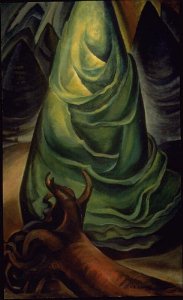 |
 |
 |
 |
 |
 |
| Gallery | Tour | Family | Writing | Issues | Team |

Adapted from:
Collard, Edgar Andrew. "The Breath and Fluid of Life".
The Montréal Gazette. October 22, 1966.
Her writing was of the same searching quality as her painting. Of some of her early stories she recorded: "I put my whole soul into them...I went down deep into myself and dug up." But of all her writing, even including her autobiography, "Growing Pains", nothing has reached out more effectively to the responsive reader than her journals, now published.
The little notebooks were, she said, to "jot" herself down in "unvarnished." What emerges is an "unvarnished" portrait of an extraordinary woman -- extraordinary in the sense of being above and beyond the ordinary, even above and beyond the usual run of "exceptional" people.
Emily Carr, the writer, may have lacked elementary grounding in the formalities of punctuation and sentence structure, but what she had was an exquisite perception and sensitiveness, an awareness and an appreciation of the importance of the things of life so often missed by those hurrying after sensation. She herself compared such things to the small candies known as "hundreds and thousands": "It was these tiny things that, collectively, taught me how to live."
Added to all this was a natural way with words -- a natural ability that she, herself, worked at, even as she worked at painting. To see in words as honestly as she saw on canvas was her goal. For her the written word very early became an aid to painting. "Writing," she found, was "a splendid sorter out of feelings...better even than paint." On another occasion she noted down: "Writing is more human than painting".
She wanted her paintings "to rock and sway with the breath and fluid of life" -- and she wanted her writing to say exactly and directly what she meant. It did.
How better could anyone describe a little mongrel dog than to say it was of "no kind, just a leg at each corner," or speak of the dreary, rainy advent of another year by saying it "sniveled in." She had no wish to "blow" herself up with "high flavored impossibilities of plots lacking reality." What she wanted was simply to "express...the everyday lovely realities that happen in front of your nose."

The aloneness of Emily Carr is evident throughout the journals. Sometimes it is almost a cry from the heart: "Why, why, why must I always stand alone in my work, away from other artists...?" But at other times there is the realization that this sense of being alone was the driving force that urged her on towards success on her own terms -- the achievement of "intensity of experience and feeling." She admitted that she liked being alone: "Things talk plainer so."
As they have now been published, the journals span the years from Emily Carr's meeting with the members of the Group of Seven, in Toronto, in 1927, to the spring of 1941. By this time the physical giving way of old age had cribbed and confined Emily Carr's joy in the freedom of woods and forest, but nothing ever confined her joy in the wonder of life.
She went for a drive on the day of the last entry in the journals. When she got back she wrote that the sun in the park was "powerful," the Olympic Mountains a "strong, delicate blue," the cat bush "already green," everything, in fact "splendid" with the "weight of flowing life."
© By permission of Edgar Andrew Collard.
 |
 |
 |
 |
 |
 |
| Gallery | Tour | Family | Writing | Issues | Team |